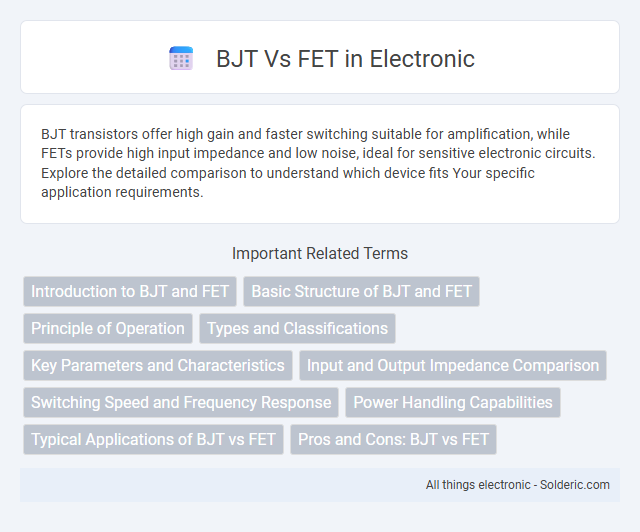BJT transistors offer high gain and faster switching suitable for amplification, while FETs provide high input impedance and low noise, ideal for sensitive electronic circuits. Explore the detailed comparison to understand which device fits Your specific application requirements.
Comparison Table
| Feature | BJT (Bipolar Junction Transistor) | FET (Field Effect Transistor) |
|---|---|---|
| Type | Current-controlled device | Voltage-controlled device |
| Input Impedance | Low (typically 100-1000 Ohms) | High (typically megaohms to gigaohms) |
| Noise | Higher noise level | Lower noise level |
| Power Consumption | Higher due to base current | Lower due to negligible gate current |
| Switching Speed | Faster switching in some power applications | Generally faster in low-power applications |
| Gain | High current gain (b) | Voltage gain possible, current gain very low |
| Construction | PNP or NPN layers | Junction or MOS structures |
| Applications | Amplifiers, switches in high-current circuits | Switching, amplifiers in high-impedance circuits, digital circuits |
Introduction to BJT and FET
BJT (Bipolar Junction Transistor) operates through both electron and hole charge carriers, making it a current-controlled device widely used for amplification and switching applications. FET (Field-Effect Transistor) relies on voltage control, utilizing an electric field to regulate conductivity, which provides high input impedance and low power consumption. Your choice between BJT and FET depends on the specific requirements of switching speed, input impedance, and power efficiency.
Basic Structure of BJT and FET
Bipolar Junction Transistors (BJT) consist of three layers of semiconductor material forming two p-n junctions, typically arranged as either NPN or PNP configurations, with three terminals named emitter, base, and collector. Field-Effect Transistors (FET) feature a channel made of semiconductor material controlled by an electric field from the gate terminal, with the most common types being Junction FET (JFET) and Metal-Oxide-Semiconductor FET (MOSFET), distinguished by their gate construction. Unlike BJTs that rely on current injection for operation, FETs primarily use voltage at the gate to modulate conductivity, reflecting their fundamental structural and functional differences.
Principle of Operation
Bipolar Junction Transistors (BJT) operate based on current control, where a small base current regulates a larger collector-emitter current through the injection and control of charge carriers (electrons and holes) in the semiconductor material. Field Effect Transistors (FET) function through voltage control, modulating the conductivity of a semiconductor channel by applying an electric field to the gate terminal, which influences the current flow between the source and drain. This fundamental difference in operation defines BJTs as current-driven devices and FETs as voltage-driven devices.
Types and Classifications
Bipolar Junction Transistors (BJTs) are classified into NPN and PNP types, based on the arrangement of their semiconductor layers, which determines current flow and voltage polarity. Field-Effect Transistors (FETs) primarily include JFETs (Junction FETs) and MOSFETs (Metal-Oxide-Semiconductor FETs), with MOSFETs further divided into enhancement-mode and depletion-mode types. These classifications affect their switching behavior, input impedance, and application suitability in analog and digital circuits.
Key Parameters and Characteristics
Bipolar Junction Transistors (BJTs) operate as current-controlled devices with high gain and faster switching speeds, making them suitable for amplification applications. Field-Effect Transistors (FETs), specifically MOSFETs, function as voltage-controlled devices with high input impedance and low power consumption, ideal for digital switching and low-noise circuits. Key parameters for BJTs include current gain (b), saturation voltage (V_CE(sat)), and switching speed, while FET parameters focus on threshold voltage (V_TH), drain-source resistance (R_DS(on)), and gate capacitance.
Input and Output Impedance Comparison
Bipolar Junction Transistors (BJTs) exhibit low input impedance due to the base-emitter junction's forward bias, typically ranging from 100 to 1,000 ohms, while their output impedance is moderate, often between a few hundred to a few kilo-ohms. Field-Effect Transistors (FETs) provide very high input impedance, often in the megaohm to gigaohm range, since the gate is insulated, leading to minimal gate current and thus low loading on preceding circuits; their output impedance is generally higher than BJTs, varying with device type and biasing conditions. This impedance characteristic makes FETs suitable for voltage amplification with minimal signal loss, whereas BJTs excel in applications requiring higher current driving capability.
Switching Speed and Frequency Response
BJTs exhibit faster switching speeds due to their majority carrier operation, allowing quicker transitions between on and off states compared to FETs, which rely on minority carrier injection. The frequency response of BJTs typically exceeds that of FETs, making them favorable in high-frequency applications such as RF amplifiers and oscillators. Your choice between BJT and FET should consider these factors to optimize circuit performance where switching speed and frequency response are critical.
Power Handling Capabilities
Bipolar Junction Transistors (BJTs) generally offer higher power handling capabilities due to their low saturation voltage and high current density, making them suitable for applications requiring significant power dissipation. Field Effect Transistors (FETs), particularly MOSFETs, provide efficient switching with lower gate drive power but typically have lower current capacity compared to BJTs. The choice between BJT and FET for power handling depends on factors like voltage rating, current requirements, and thermal management in the specific electronic circuit.
Typical Applications of BJT vs FET
BJTs are commonly used in applications requiring high current gain and fast switching, such as in amplifiers, oscillators, and analog circuits. FETs excel in low-power, high-input-impedance applications including digital circuits, voltage-controlled resistors, and RF amplifiers. Your choice depends on whether you need the current-driven characteristics of BJTs or the voltage-driven control and energy efficiency of FETs.
Pros and Cons: BJT vs FET
BJTs offer high current gain and fast switching speeds, making them ideal for amplification, but they consume more power and have lower input impedance compared to FETs. FETs provide high input impedance and low power consumption, enhancing your circuit's efficiency and reducing noise, but they typically have slower switching speeds and lower current capacity. Choosing between BJT and FET depends on your specific application's requirements for speed, power efficiency, and input impedance.
BJT vs FET Infographic

 solderic.com
solderic.com